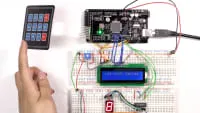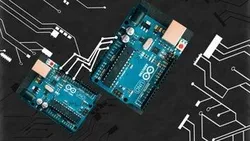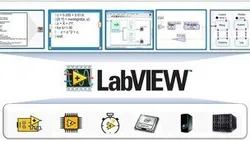
Learning Arduino: Interfacing with Hardware 
Gain the skills to create interactive electronics with the Arduino microcontroller and components like LCD screens, LEDs, and keypads with this comprehensive guide to Learning Arduino: Interfacing with Hardware. ▼
ADVERTISEMENT
Course Feature
![]() Cost:
Cost:
Free Trial
![]() Provider:
Provider:
LinkedIn Learning
![]() Certificate:
Certificate:
No Information
![]() Language:
Language:
English
Course Overview
❗The content presented here is sourced directly from LinkedIn Learning platform. For comprehensive course details, including enrollment information, simply click on the 'Go to class' link on our website.
Updated in [March 06th, 2023]
This course, Learning Arduino: Interfacing with Hardware, provides an introduction to the Arduino microcontroller and demonstrates how to connect it to three common components: an LCD screen, a seven-segment LED, and a keypad. Zahraa Khalil will guide learners through the process of wiring and programming the interfaces and performing basic tasks such as displaying randomised numbers, looping through an LED pattern, and accepting keypad input. The course includes zoomed-in, hands-on demonstrations of how to finish the physical wiring as well as tutorials that walk learners through high-level Arduino concepts and practical coding techniques. By the end of the course, learners will have the knowledge and skills to make their own electronics using this popular maker technology platform.
[Applications]
After completing this course, learners can apply their knowledge of Arduino to create interactive projects that involve hardware components such as LCD screens, seven-segment LEDs, and keypads. They can also use the Arduino microcontroller to wire and programme the interfaces and perform basic tasks such as displaying randomised numbers, looping through an LED pattern, and accepting keypad input. Additionally, learners can use the knowledge gained from this course to explore other maker technology platforms.
[Career Paths]
1. Embedded Systems Engineer: Embedded systems engineers are responsible for designing, developing, and testing embedded systems. They use Arduino to create interactive digital projects that are linked to lights, sensors, and motors. As the demand for connected devices increases, the need for embedded systems engineers is expected to grow.
2. Robotics Engineer: Robotics engineers use Arduino to create robots that can interact with their environment. They use the microcontroller to program the robots and control their movements. With the increasing demand for automation, robotics engineers are in high demand.
3. IoT Developer: IoT developers use Arduino to create Internet of Things (IoT) devices. They use the microcontroller to program the devices and connect them to the internet. As the demand for connected devices increases, the need for IoT developers is expected to grow.
4. Automation Engineer: Automation engineers use Arduino to create automated systems. They use the microcontroller to program the systems and control their operations. With the increasing demand for automation, automation engineers are in high demand.
[Education Paths]
1. Electrical Engineering: Electrical engineering is a field of engineering that deals with the study and application of electricity, electronics, and electromagnetism. It is a rapidly growing field, with new technologies and applications being developed every day. Electrical engineers are responsible for designing, developing, and testing electrical components, systems, and equipment. Electrical engineering is a great choice for those interested in learning about Arduino and its applications.
2. Computer Science: Computer science is the study of computers and their applications. It involves the design, development, and implementation of computer systems and software. Computer science is a great choice for those interested in learning about Arduino and its applications, as it provides a strong foundation in programming and software development.
3. Robotics: Robotics is the study of robots and their applications. It involves the design, development, and implementation of robotic systems and software. Robotics is a great choice for those interested in learning about Arduino and its applications, as it provides a strong foundation in programming and software development, as well as the ability to create and control robotic systems.
4. Mechatronics: Mechatronics is a field of engineering that combines mechanical engineering, electrical engineering, and computer science. It involves the design, development, and implementation of mechatronic systems and software. Mechatronics is a great choice for those interested in learning about Arduino and its applications, as it provides a strong foundation in programming and software development, as well as the ability to create and control mechatronic systems.
The development trends for these degree paths are all related to the increasing use of technology in everyday life. Electrical engineering, computer science, robotics, and mechatronics are all fields that are growing in importance as technology becomes more and more integrated into our lives. As technology advances, so too do the opportunities for those with these degrees.
Course Syllabus
Introduction to the liquid crystal display (LCD)
Understanding HD4470 controller
The LCD interface
Wire up the LCD
Coding the LCD interface
Optional review: Understanding "for" loops
Optional review: Understanding arrays
Displaying random numbers and scrolling
Course Provider

Provider LinkedIn Learning's Stats at AZClass
Discussion and Reviews
0.0 (Based on 0 reviews)
Explore Similar Online Courses

IT Fundamentals for Business Professionals: Software development

Asynchronous JavaScript (2020 version)

Python for Informatics: Exploring Information

Social Network Analysis

Introduction to Systematic Review and Meta-Analysis

The Analytics Edge

DCO042 - Python For Informatics

Causal Diagrams: Draw Your Assumptions Before Your Conclusions

Whole genome sequencing of bacterial genomes - tools and applications

Arduino Communication with SPI Protocol

Interfacing LabVIEW With Arduino via LINX

Arduino SMS Sending Motion Detector using Python
 Related Categories
Related Categories
 Popular Providers
Popular Providers
Quiz
 Submitted Sucessfully
Submitted Sucessfully
1. What is the purpose of this course?
2. What components does the course demonstrate how to connect to the Arduino microcontroller?
3. What type of technology platform is Arduino?


Start your review of Learning Arduino: Interfacing with Hardware